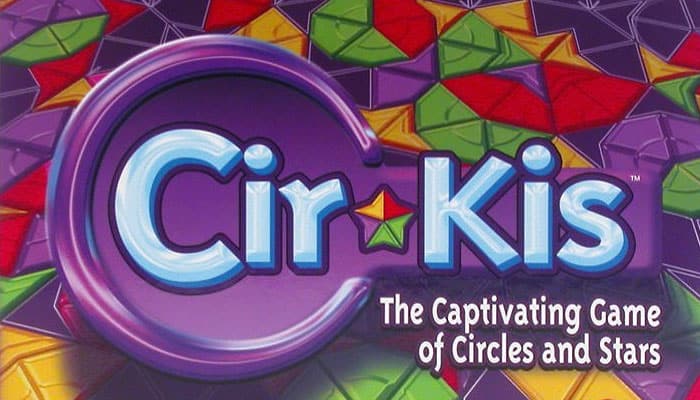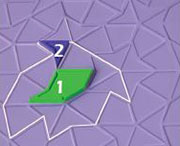

Components
- Dimensional plastic game board unit
- 4 sets of 20 colorful playing pieces
- 4 scoring pegs
- illustrated instructions
The Cir*Kis board, which has a storage compartment and scoring track for each player and a central playing area, and 4 sets of plastic pieces.
Each set consists of 20 pieces and a scoring peg.

Object of the Game
Players take turns placing a piece on the board next to the last piece played (the "Leader"). Completing Circles and Stars scores points.
The first player to score 40 points wins the game. The game can also end if one player plays his final piece or if no further plays are possible, in which case high score wins.
Setup
Arrange the board so that each player is seated behind a corner. Select a set of pieces. Put your scoring peg in the "0" hole near your compartment.
Arrange your pieces on the table (this makes it easier for all to see which pieces haven't been played).
Game Play
 The Center Ring and Star |
The youngest player is first to place a piece. At least part of it must be inside the Center Ring or Center Star.
Pieces can only be played where they fit. They "snap" into place when placed properly. Play passes to the left throughout the game.
Follow the leader
There is only one rule when placing a piece: Each new piece must touch the last piece played (the Leader).

Green plays first. All spaces enclosed by the line touch Green's piece.
Purple plays next as shown. His piece touches Green's.

Purple's piece becomes the new Leader.

The next four pieces "Follow the Leader" as shown.
Pieces "touch" when edge-to-edge, or even just point-to-point, like Purple's #2 piece in the illustration above.
Free Turn
There are three ways you may gain a free turn:
- You place a piece in a space whose adjacent spaces are all filled.
- You complete the central Star.
- You place the first Sliver piece. No subsequent Sliver piece is awarded a free turn. (Note: the two Sliver spaces adjacent to a star touch point-to-point).

If Purple plays here, he will receive a free turn because all adjacent spaces are filled.

These two spaces are adjacent to each other.
Whenever you gain a free turn, you immediately place another piece so that it touches any other piece on the board. This piece becomes the new Leader. A free turn often provides a great opportunity to increase your score.
Scoring
There are five segments in each shape (Circle or Star) on the board. Whenever a Circle or a Star shape is completed, you score 10 points if you have the most segments in the shape.
Advance your scoring peg accordingly. 5 bonus points are awarded to the opponent who completes either shape. If you complete a shape and score its 10 points, you do not score the 5-point bonus.

Red will score 15 points: 10 for having the most segments in the Star and 5 bonus points for completing the Circle.
Green scores 10 points for having the most segments in the Circle. (Purple scores no points for his 2 segments in the Star).
Note: If two players each have two segments in a completed shape, no score is awarded except the 5-point completion bonus.

There are ten Circles and six Stars on the board.
Losing a Turn
You lose a turn if you can't place a piece (because the grid spaces next to the leader won't accommodate any of your remaining pieces).
If all players lose their turn in succession, the game ends.
End of the Game
As soon as a player scores 40 or more points, play stops at the end of his turn.
If no player reaches 40 points, the game ends when one player plays his final piece ("goes out") or when no player can play another piece.
A player who goes out scores 10 bonus points.
High score wins. If the game ends in a tie, the player involved who has the most unplayed pieces wins. If still tied, the victory is shared.
Optional Rules
The ten spaces around the central Star comprise the "Center Ring". Award 15 points to the player who has the most segments among these ten when, and if, the Center Ring is completed. (The 5-point bonus is awarded as well, if a different player completes the Ring).
For a longer game, play more rounds until one player has scored 100 points.
Continue Reading


